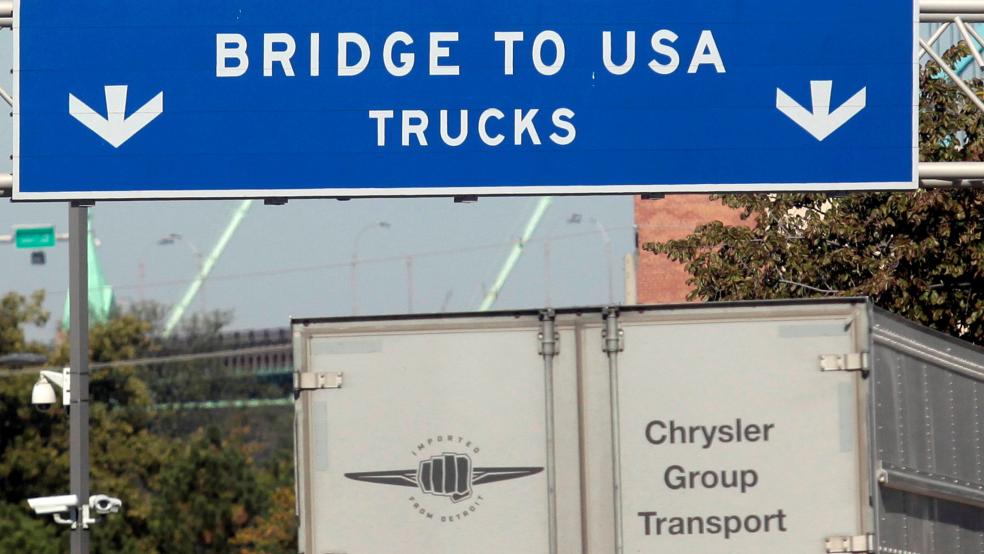In a press conference on Thursday, President Trump once again floated the idea that he could, almost on a whim, withdraw the United States from the North American Free Trade Agreement. The comments came just a day after the White House indicated that the president was planning to exit the trade deal between the U.S., Mexico and Canada, and then reversed course with a late-night press release.
“I was going to terminate NAFTA as of two or three days from now, the president of Mexico -- who I have a very good relationship with, called me -- and also the prime minister of Canada who I have a very good relationship. I like both of these gentlemen very much -- they called me and they said rather than terminating NAFTA, could you please renegotiate,” Trump said during a brief appearance in the Oval Office.
Related: Was NAFTA Really So Bad for the Economy?
“If you check my campaign, any of my speeches, I said I'll either renegotiate or I'll terminate,” he added. “So they asked me to renegotiate and I will and I think we'll be successful in the negotiating which, frankly, would be good.”
The president’s shifting position on the trade deal -- which he has called the “worst ever” -- raises related questions about what he can actually do unilaterally, to exit NAFTA or to materially change its terms.
Can Trump Exit NAFTA?
The short answer is: Yes, he probably can, but it wouldn’t be quick and it probably would be messy.
The agreement itself actually has a simple process for a country that wishes to quit: Article 2205, titled “Withdrawal,” says the following: “A Party may withdraw from this Agreement six months after it provides written notice of withdrawal to the other Parties. If a Party withdraws, the Agreement shall remain in force for the remaining Parties.”
There may be quibbling about who the “party” in question is in this case. Is it Trump? Is it the U.S. government, which includes Congress? It’s not a question that has been tested in the courts very often, but in at least two cases -- George W. Bush leaving the Anti-Ballistic Missile Treaty in 2001 and Jimmy Carter terminating the Sino-American Mutual Defense Treaty in 1979 -- presidents have successfully withdrawn the U.S. from treaties on their own. Bush’s move went unchallenged. An effort by Republican senators to block Carter’s was dismissed for lack of standing.
Related: Trump Makes a Lot of Noise on NAFTA: Is This the Art of the Deal?
In addition, a relatively obscure portion of the 1974 Trade Act, which governs U.S. trade agreements with other countries, grants the president substantial authority to extract the U.S. from trade agreements on his own.
However, he would be required to publicly explain his decision and to allow opponents the opportunity to challenge his reasoning.
The law says that “before taking any action” to withdraw or alter a trade deal, “the President shall provide for a public hearing during the course of which interested persons shall be given a reasonable opportunity to be present, to produce evidence, and to be heard, unless he determines that such prior hearings will be contrary to the national interest because of the need for expeditious action, in which case he shall provide for a public hearing promptly after such action.”
So, bottom line, Trump can probably pull the U.S. out of NAFTA all by himself if he decides he wants to.
However, if he does, there is still the matter of hundreds of implementing regulations -- based on federal laws passed by Congress -- that will remain on the books if he does. It would be a hugely complicated task to restructure the country’s trade relationships with two of its largest trading partners.
Can Trump Renegotiate NAFTA?
Curiously, this might be slightly harder for Trump to do that leaving the treaty altogether -- at least in terms of beginning the process.
Related: Time to Think Twice About Those Tax Cuts and the Deficit
One of the reasons is purely procedural. The law requires the president to give Congress 90 days’ notice before beginning the renegotiation process, and that 90-day clock doesn’t start ticking until Congress is formally notified by the U.S. trade representative. Trump doesn’t currently have a U.S. trade representative. He has nominated attorney Robert Lighthizer to the position, but he has not yet been confirmed.
In reality, congressional oversight committees could accept notice from someone else, but Democrats on the committees are insisting that Lighthizer be confirmed before they will meet with the administration on trade issues.
The other reason is political. NAFTA is 26 years old and is inextricably woven into the fabric of North American commerce. If the administration opens the door to a major renegotiation, the number of powerful interest groups and influential lobbies that will want to provide input will be enormous.
And Trump would also have to contend with the people sitting on the other side of the table. Mexican officials, in particular, have become increasingly vocal about the kind of hardball tactics they would be willing to use if Trump tries to blow up a system that has generally served their country pretty well.
Earlier this year, Mexican Foreign Minister Luis Videgaray said that in NAFTA negotiations, more than just NAFTA could be on the agenda. “Mexico is an important country for the U.S. on security issues, on combating organized crime, preventing terror and, of course, cooperating on immigration," he said in March. “All matters are on the table simultaneously.”





